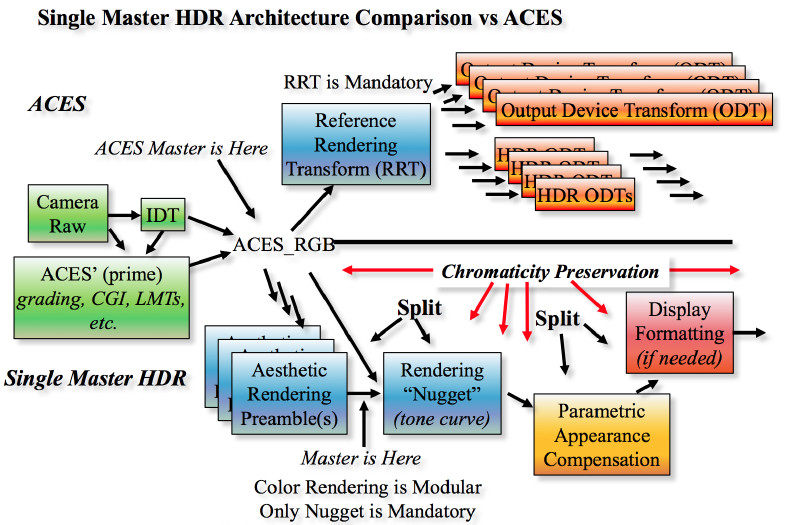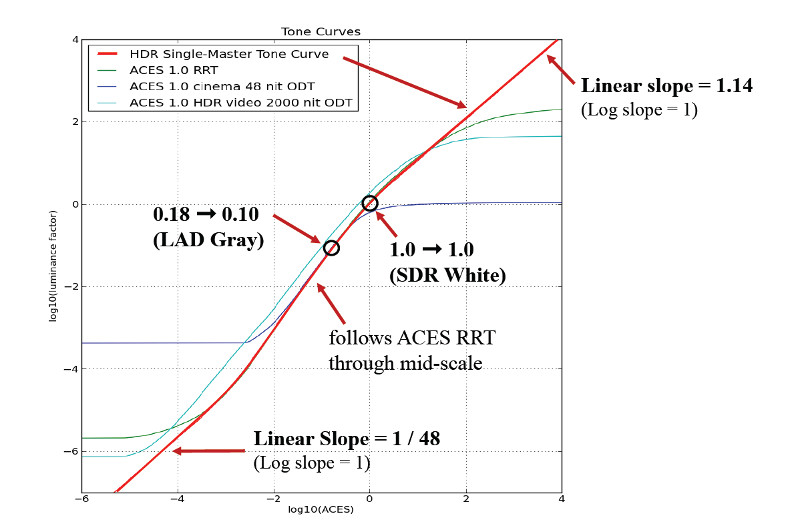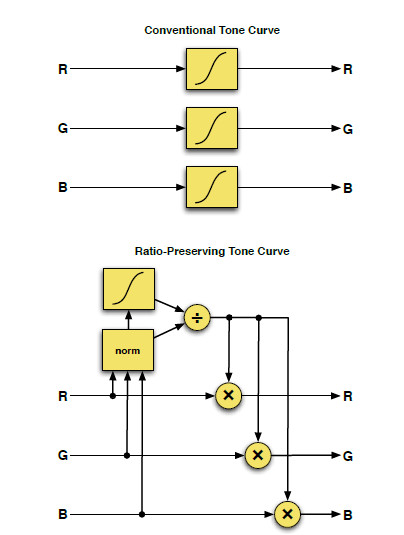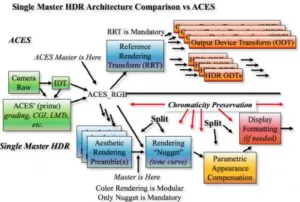Gary Demos of Image Essence and Doug Walker from Autodesk Media & Entertainment gave a very good presentation on a new color management solution that they believe should be considered for the next version of ACES, the color management solution release by the Academy of Motion Picture Art and Sciences.
However, to understand why Demos and Walker think an update is needed, we need a little background on ACES 1.0, which was formally released at NAB 2015 after 10 years of development (see video). Matt Brennesholtz also gave a good summary of the features in November 2016, which I paraphrase next.
All About ACES
ACES was started as a file format project to create a common format for all the assets used in production and post production. Dozens of formats existed, making conversions difficult and archiving nearly impossible. The idea is to transform all of your assets into one common linear light file format which was large enough to contain a very wide range of luminance and color values. ACES 1.0 adds a full workflow for the conversion of source materials into the common ACES format via a series of input device transforms (IDTs) tailored for each source format.
In the ACES format, which is based on RGB, common editing, effects and color grading tools can be used to finish the content. Having all the assets in a common ACES format makes it much easier to match up white points and colors from various cameras or other assets to create a uniform look. The finished work is referred to as the ACES master.
To display content, it is first rendered using the Reference Rendering Transform (RRT) which applies a mandatory transform to a specific color space and grayscale range as a first step. The user then selects one of a number of Output Device Transforms (ODTs) that are tailored for specific display platforms such as a cinema projector or grading monitor. These transforms massage the color volume and gray scale accounting for the capabilities of the target display and the viewing environment. These transforms are designed to be done in real time on available hardware.
ACES Has Problems
The problems that Demos and Walker are trying to solve were identified as:
- Clamping outside the rendering primaries
- Inversion problems
- Output Transforms have some hue and saturation distortion
According to Demos, the RRT, which manipulates color and gray scale simultaneously, desaturates dark and bright tones while boosting saturation in the mid tones. These errors then get passed on to the ODT and become visible on certain scenes. Unfortunately, the RRT is not reversible, so you can’t get back to the ACES master data very easily and alternative RRTs are not allowed, so it becomes very difficult to fix any final errors.
The idea that Demos and Walker are proposing is to split up the RRT into separate color (aesthetic rendering preambles) and gray scale modules (Nugget tone curve) and split up the ODT into two parts that allows for device specific adjustments to color and luminance (display formatting) but also have separate modules they call parametric appearance compensation, which adjusts colors and luminance based upon the viewing environment. The current ACES workflow and the proposed new modules are shown in the graphic below. They believe this approach is more flexible and preserves chromaticity from start to finish. The ACES master is now considered the point after aesthetic rendering preambles are applied.

At a companion demo session we attended at the home of Joe Kane, Demos showed a number of color charts and other HDR images where he pointed out the problems with the ACES 1.0 rendering and how his algorithms can fix these issues. In particular, problems with clipping as well as hue and saturation shifts were evident with ACES 1.0.
The new HDR single-master tone curve (Nugget) that Demos and Walker propose is shown in the graph below along with the ACES 1.0 RRT and RRT/ODT combinations. He says this follows the ACES 1.0 curve in the mid-tones, but deviates in the bright and dark tones. 18% gray in the scene is mapped to 10% of the SDR white point (i.e., 4.8 cd/m² for cinema, 10 cd/m² for television), which is the customary placement for cinema and dramatic television.

Demos said they spent a lot of time looking at the shape of the curve, especially the highlights and low lights to get something that performed well, which is why they settled on the linear slope regions as indicated. The shape also makes it invertible to transform forward or backward over a very wide range.
Color
Turning to how colors are handled, Demos and Walker detailed a number of very complicated issues with color rendering (you should read the paper to fully understand all the issues). But the bottom line was that ACES 1.0 introduces unacceptable hue and saturation distortions, especially with HDR content. Plus, ACES effective clips (clamps) colors that are outside of the primary capabilities of the display, as specified in the ODT.
Their solution for the Single-Master HDR Architecture is a “norm-based ratio-preserving tone-scale,” as shown in the diagram below. Rather than applying the tone curve to R, G, and B independently, a norm (basically an average) is calculated from R, G, and B and the tone curve is applied to the norm. This results in a gain factor that is then applied equally to R, G, and B.
Because the same gain factor is applied to R, G, and B, the original ratios between the channels is preserved. Roughly speaking, this implies that the hue and saturation are also preserved. The basic concept of applying tonal modifications via a gain factor is not new. In fact, it is used in the ACES system (for the surround correction in the video ODTs) as well as in Rec. 2100 (HLG). What is new in the present work is the design of the norm.

The two then described their weighted yellow power norm, which leveraged a number of previous efforts but made some improvements by spending a lot of time looking at pictures with their new norm vs. other versions. The formula is shown below for those really interested and is independent of the RGB primaries. – CC


